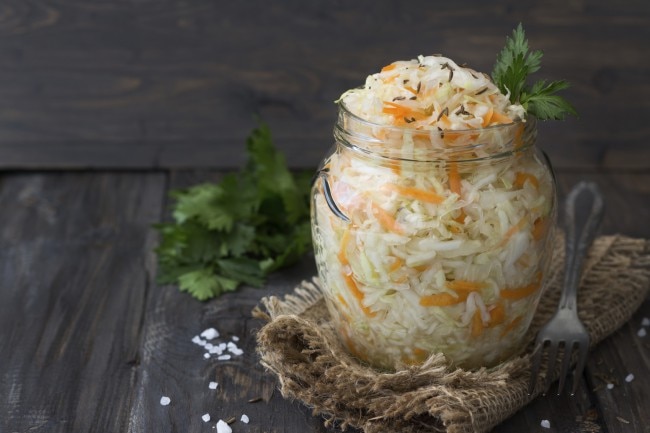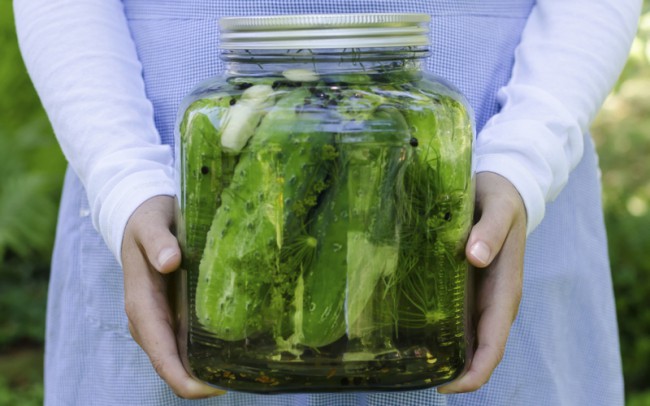The new buzzword in food is bacteria—as in the more the merrier. As a fomentation about fermentation brews across the nation, more and more people are rediscovering the health benefits of foods that harken back to a more traditional relationship with preservation. Bread, cheese, alcohol, soy sauce, vinegar, pickles—even chocolate—are fermented foods that we ingest daily.
Fermented foods, whose taste has been transformed by the introduction of bacteria, give credence to the belief that microbes can be friend as well as foe. Not only does fermentation extend a food’s shelf life, but it alters foods in a variety of ways, “all of which make the nutrients in the food more readily available,” says Sandor Katz, a fermentation revivalist whose book, The Art of Fermentation (Chelsea Green Publishing, 2012), is now in its third printing.
From pride of place in hip New York City restaurants to valuable bartering tools in neo-communes, fermented foods are boldly reclaiming the limelight with their distinctive taste, health benefits and crock-to-table immediacy. “We cannot survive without bacteria,” says Katz. When it comes to fermented foods, diversity is the most important thing, with variety breeding (literally) variety.
Fermentation makes foods more digestible, especially when it comes to dense nutrients such as those found in soybeans, dense in concentrated protein. Extracting the protein from soybeans remains a futile mission for human digestion, unless the soybeans have been broken down into more-accessible amino acids. What’s more, fermented foods replenish the stores of probiotic bacteria in our guts. Finally, cultured foods play a huge role—the scientific research is just beginning to catch up—in our immune functioning and in many other processes in our bodies.*
In the sweet spot between raw and ripened await the complex flavors—think pungent, sour, sharp, spicy, sweet—of cultured foods such as kimchi, natto, tempeh, mead, kombucha and miso. Indeed, for such an evangelist of funky foods, it’s hard for Katz to narrow his selection to a top three, and to do so, he says, would be misleading. His creed is, “Consciously replenish and diversify your populations of bacteria.”
But his following three picks are a good place to begin, with both sauerkraut and kefir relatively easy to make yourself. As Katz says, the taste that one’s own hands add to the mix is part of what gives food its secret juju.
Sauerkraut
Because he appreciates its familiar taste and health-giving properties, Katz, whose nickname is Sandorkraut, calls sauerkraut—typically shredded cabbage and salt—an ideal place to begin your experiment with fermentation. Because sauerkraut has all the benefits of a live-culture ferment, Katz recommends eating sauerkraut daily. The Lactobacilli created in the fermenting process increase vitamin levels, produce a variety of helpful enzymes and promote the growth of healthy flora throughout the digestive tract. A study published in the October 2002 Journal of Agricultural and Food Chemistry suggested that fermenting cabbage produces compounds known as isothiocyanates that can support health.*
Feeling inspired to do it yourself? Here is a step-by-step guide to making your own.
If not, find plenty of sauerkraut options on Vitacost.com.
Kefir
While Katz describes any cultured milk product as probiotic and beneficial, he believes that kefir’s complex microbes make it even more potent than most, including yogurt. Made from a starter of gelatinous particles called kefir grains, kefir contains seven to 10 probiotic cultures, which together provide a powerful support for the immune system. A study published in the March 2010 issue of the British Journal of Sports Medicine showed that professional long-distance runners who consumed the probiotic Lactobacillus (in the form of a dietary supplement) had shorter and less severe bouts of respiratory illness than those runners who took a placebo.
Although kefir-like drinks made from fruit juices and coconut water abound, true kefir is made from a base of dairy. To make kefir yourself, you need to find bona fide kefir grains—not the powdered kefir starters that many health food stores sell (which do not contain the authentic grains that comprise true kefir). Once you get your hands on those, try your hand at making your own kefir.
Miso
Though many people have been exposed to miso soup en route to sushi, Katz exhorts people to think outside the bowl. Miso, a salty paste made from fermented soybeans, is a staple of Japanese cuisine. Katz suggests using miso as a base for marinades and salad dressings, mixed with yogurt and as a spread combined with nut butters. Packed with nutrients, along with its salutatory bacteria and enzymes, miso provides protein, vitamin B12, vitamin B2, vitamin E, vitamin K, choline, linoleic acid, lecithin and even dietary fiber. While homemade miso would be an ambitious project for the novice, there are plenty of wonderful misos available commercially. Certified organic miso made with sea salt, unpasteurized and without preservatives is the best option—and miso should ideally have a fermentation time of between six months and two years.
If you’re hungry for more fermented fare, take a stab at these probiotic-rich pickled cucumbers:
Ingredients
5 whole cucumbers
1 Tbsp. dill seed
2 tsp. mustard seed
1 Tbsp. sea salt
Room-temperature water
Directions
- In a quart-sized jar, arrange whole cucumbers.
- Pour in remaining ingredients, making sure water level is 1/2-in. below top of jar rim. Cover jar.
- Set jar aside at room temperature for three to five days.
- Store pickles in refrigerator indefinitely.
- Enjoy as a snack, a side dish, in salads or in stir-fry dishes.
*These statements have not been evaluated by the FDA. These products are not intended to diagnose, treat, cure or prevent any disease.



